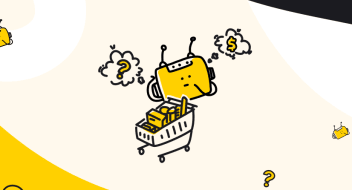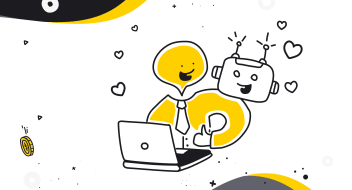Showing top 0 results 0 results found
Showing top 0 results 0 results found

Ecommerce sales have steadily increased yearly. In 2022, global ecommerce sales were projected to reach $4.9 trillion, up from $4.2 trillion in 2021. Do you want more evidence with solid digits? Glad you asked. Here you'll find interesting key chatbot statistics you should follow in 2023.
With so much competition in the digital marketplace, optimizing sales is more critical than ever. That's where chatbots come in.
In this article, I'll explore the various stages of the sales funnel and show how chatbots can guide users through each step. I'll also highlight the benefits of using chatbots for sales. So let's dive in and discover the way chatbots can revolutionize how you organize your digital marketing strategy and do business with your sales team.
🤖 Does your sales process need a boost?
What is a sales chatbot and why do you need it?

A sales chatbot is an AI agent (AI) designed to interact with customers and help guide them through the sales process. These chatbots can be integrated into various messaging platforms, such as Facebook Messenger (messenger marketing), WhatsApp, or a company's website or app.
A chatbot can be implemented no matter the scale of your business and the size of your sales team. If you're wondering if it fits your small project with handmade insulated woolen panties, here is the guide on how a small company can use a chatbot to boost growth.
One of the main benefits of using a sales chatbot is improved efficiency. Chatbots can handle a high volume of customer inquiries and support requests without human intervention, which frees your team to focus on other tasks. Additionally, chatbots can offer 24/7 support, ensuring that customers always have access to help when needed.
Another benefit of using a sales chatbot is increased customer satisfaction. Chatbots can provide personalized recommendations and help customers find the products or services that best fit their needs.
They can also answer frequently asked questions, provide information about discounts and promotions, and offer support throughout the sales. This can help customers feel more engaged in purchasing, leading to higher satisfaction and loyalty.
Finally, using a sales chatbot can enhance lead generation and conversion. Chatbots can help identify potential customers and gather contact information like email addresses or phone numbers.
They can also support decision-making by sending personalized product recommendations or offering exclusive promo codes. By providing a seamless and engaging experience, chatbots can help convert more leads into paying customers.
To learn more about how artificial intelligence can boost your sales, read this article on how to power your online sales with AI tools.
What are the stages of a sales funnel, and how can you use chatbots to guide the customer through them?
I realize you know very well what a sales/marketing funnel is, but let's do a quick recap to ensure we're on the same page. A marketing funnel is a model that describes the customer's journey toward purchasing a product or service.
It outlines a customer's stages, from initial awareness to final purchase, and helps businesses optimize their sales process. The sales funnel typically consists of four stages: Awareness, Interest, Decision, and Action.
Let's find out how chatbots can help you in the first stage and how you can develop a chatbot funnel strategy.
A. Awareness
At the top of the sales funnel is the awareness stage. This is where potential customers first become aware of your brand and your products or services. This stage aims to build brand awareness and attract potential customers. With the help of a sales chatbot, you can proactively reach out to users and educate them about your products or services.
By using chatbots, you can communicate your brand's mission and values to your customers. They can also provide relevant information about your products and services, giving potential customers a better understanding of your offer. Overall, chatbots can be an essential tool in guiding users through the awareness stage of the sales funnel.
B. Interest
Once users know your brand and its offerings, the next stage is to engage their interest. This is where chatbots can shine! By engaging users in conversation, chatbots can understand their needs and preferences and offer tailored recommendations.
Chatbots can also showcase the features and benefits of your products or services, provide helpful information, and answer any user questions. For example, a chatbot for a clothing brand might ask the user about their preferred style, budget, and occasion and then offer them personalized outfit suggestions.
C. Decision
The decision stage is when users are ready to purchase. Chatbots can assist with this process by guiding customers through checkout and helping them with any issues or concerns.
For example, a chatbot for an ecommerce store might offer support with shipping and payment options, provide order tracking information, or help the user apply a coupon code.
Additionally, chatbots can give personalized promotions or discounts to incentivize users to complete their purchases.
D. Retention
Congratulations! The customer user has made a purchase. But the journey doesn't end there. The retention stage is all about maintaining the relationship with the customer, providing post-purchase support, and encouraging future purchases.
Chatbots can provide valuable resources and support to customers after their purchase, such as order status updates, returns or exchange information, and product recommendations based on their previous purchases.
They can also send personalized follow-up messages or surveys to gather feedback and improve customer experience. Chatbots can help turn one-time customers into loyal brand advocates by providing excellent post-purchase support.
E. Even More Stages!
After the retention stage, there's still more that chatbots can do to support your sales efforts. With their ability to engage customers and provide personalized assistance, chatbots can help in various post-purchase actions. They can facilitate the ordering process, making it seamless and efficient for customers to place their orders. Chatbots can also assist in upselling and cross-selling, suggesting complementary products or services that align with the customer's interests and preferences.
Furthermore, chatbots can help customers leave their contact information, sign up for newsletters, or manage bookings for appointments or reservations. By offering surveys and quizzes, chatbots can generate valuable leads and gather feedback that can be used to enhance your products or services.
Additionally, chatbots can play a crucial role in preventing cart abandonment. By engaging with customers who have items in their cart but still need to complete the purchase, chatbots can provide personalized assistance, address concerns, and offer incentives to encourage them to finalize their transactions.
To further explore the post-sale tips and strategies, check out this article about the post-sale process for valuable insights on how chatbots can enhance the post-purchase experience in the retail industry.
🤖 Does your sales process need a boost?
Cracking the sales code: empowering your strategy with chatbot funnels
In conclusion, chatbots can be a powerful tool for guiding customers through the marketing funnel, from awareness to qualified leads and retention. With their ability to engage in conversations, understand customer needs, and offer support, chatbots can improve efficiency, increase customer satisfaction, generate leads, and enhance conversion.
As technology continues to evolve, the possibilities for chatbots in sales are endless. So explore the benefits of using chatbots for your business and see how they can help take your sales process to the next level!



